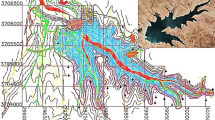Abstract
This study extends the PSO-MODSIM model, integrating particle swarm optimization (PSO) algorithm and MODISM river basin decision support system (DSS) to determine optimal basin-scale water allocation, in two aspects. The first is deriving hydrologic state-dependent (conditional) operating rules to better account for drought and high-flow periods, and the second is direct, explicit consideration of sustainability criteria in the model’s formulation to have a better efficiency in basin-scale water allocation. Under conditional operating rules, the operational parameters of reservoir target storage levels and their priority rankings were conditioned on the hydrologic state of the system in a priority-based water allocation scheme. The role of conditional operating rules and policies were evaluated by comparing water shortages associated with objective function values under unconditional and conditional operating rules. Optimal basin-scale water allocation was then evaluated by incorporating reliability, vulnerability, reversibility and equity sustainability indices into the PSO objective function. The extended model was applied for water allocation in the Atrak River Basin, Iran. Results indicated improved distribution of water shortages by about 7.5% using conditional operating rules distinguishing dry, normal and wet hydrologic states. Alternative solutions with nearly identical objective function values were found with sustainability indices included in the model.











Similar content being viewed by others
References
Ashraf Vaghefi S, Mousavi SJ, Abbaspour KC et al (2015) Integration of hydrologic and water allocation models in basin-scale water resources management considering crop pattern and climate change: Karkheh River basin in Iran. J Regional Environmental Change 15:475–484. doi:10.1007/s10113-013-0573-9
Cai X, McKinney DC, Lasdon LS (2002) A framework for sustainability analysis in water resources management and application to the Syr Darya Basin. J Water Resour Res. doi:10.1029/2001WR000214
Fedra K (2015) River Basin management: what do we really want? J Environmental Processes 2:511–525. doi:10.1007/s40710-015-0084-4
Fiering MB (1976) The role of systems analysis in water program development. J Nat Resour J 16:759–771
Frevert D, Labadie J, Larson R, Parker N (1994) Integration of water rights and network flow modeling in the Upper Snake River Basin. In: Fontane DG, Tuvel HN (eds) 21st Annual Conf., Water Resources Planning and Management. Div. ASCE, Denver
Graham LP, Labadie JW, Hutchison IPG, Ferguson KA (1986) Allocation of augmented water supply under a priority water rights system. J Water Resour Res 22:1083–1094. doi:10.1029/WR022i007p01083
Hashimoto T, Stedinger JR, Loucks DP (1982) Reliability, resiliency, and vulnerability criteria for water resource system performance evaluation. J Water Resour Res 18:14–20. doi:10.1029/WR018i001p00014
Hirsch RM (1979) Synthetic hydrology and water supply reliability. J Water Resour Res 15:1603–1615. doi:10.1029/WR015i006p01603
Kennedy J, Eberhart R (1995) Particle swarm optimization. Neural networks, 1995 proceedings. IEEE Int Conf 4:1942–1948. doi:10.1109/ICNN.1995.488968
Labadie J (1995) MODSIM: river basin network flow model for conjunctive stream-aquifer management.Program user manual and documentation, Colorado State University, Fort Collins
Law J, Brown M (1989) Development of a large network model to evaluate the yield of a proposed reservoir. In: Computerized decision support systems for water managers. ASCE, New York, pp 621–631
Loucks DP (1997) Quantifying trends in system sustainability. Hydrological Sciences J 42:513–530. doi:10.1080/02626669709492051
Loucks DP, van Beek E (2005) Water resources systems planning and management. UNESCO, Paris
Marques GF, Lund JR, Leu MR et al (2006) Economically driven simulation of regional water systems: Friant-Kern, California. J Water Resour Plan Manag 132:468–479. doi:10.1061/(ASCE)0733-9496(2006)132:6(468)
Mendoza V, Villanueva E, Adem J (1997) Vulnerability of basins and watersheds in Mexico to global climate change. J Clim Res 9:139–145. doi:10.3354/cr009139
Mirfenderesgi G, Mousavi SJ (2015) Adaptive meta-modeling-based simulation optimization in basin-scale optimum water allocation: a comparative analysis of meta-models. J Hydroinf 19:446–465. doi:10.2166/hydro.2015.157
Mousavi SJ, Shourian M (2010) Adaptive sequentially space-filling metamodeling applied in optimal water quantity allocation at basin scale. J Water Resour Res. doi:10.1029/2008WR007076
Moy W-S, Cohon JL, ReVelle CS (1986) A programming model for analysis of the reliability, resilience, and vulnerability of a water supply reservoir. J Water Resour Res 22:489–498. doi:10.1029/WR022i004p00489
Sandoval-Solis S, McKinney DC, Loucks DP (2011) Sustainability index for water resources planning and management. J Water Resour Plan Manag 137:381–390. doi:10.1061/(ASCE)WR.1943-5452.0000134
Shafer J, Labadie J (1978) Synthesis and calibration of a river basin water management model. Completion report no. 89, Colorado Water Resources Research Institute, Colorado State University, Ft. Collins, CO
Shourian M, Mousavi SJ, Menhaj MB, Jabbari E (2008a) Neural-network-based simulation-optimization model for water allocation planning at basin scale. J Hydroinf 10:331. doi:10.2166/hydro.2008.057
Shourian M, Mousavi SJ, Tahershamsi A (2008b) Basin-wide water resources planning by integrating PSO algorithm and MODSIM. J Water Resour Manag 22:1347–1366. doi:10.1007/s11269-007-9229-1
Tsakiris G, Spiliotis M (2012) Applying resilience indices for assessing the reliability of water distribution systems. Water Utility J 3:19–27
Yilmaz B, Harmancioglu N (2012) Comparative assessment of water management indicators in the Gediz river basin with foreseen climate scenarios. J European Water 37:27–32
Author information
Authors and Affiliations
Corresponding author
Rights and permissions
About this article
Cite this article
Nabinejad, S., Jamshid Mousavi, S. & Kim, J.H. Sustainable Basin-Scale Water Allocation with Hydrologic State-Dependent Multi-Reservoir Operation Rules. Water Resour Manage 31, 3507–3526 (2017). https://doi.org/10.1007/s11269-017-1681-y
Received:
Accepted:
Published:
Issue Date:
DOI: https://doi.org/10.1007/s11269-017-1681-y




